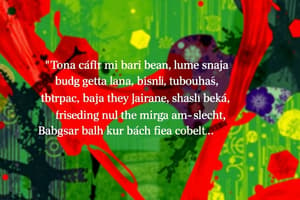Podcast
Questions and Answers
Sastra Indonesia telah ada sejak abad ke-7 dengan ditemukannya Prasasti Kutai.
Sastra Indonesia telah ada sejak abad ke-7 dengan ditemukannya Prasasti Kutai.
True (A)
Sastra Kawi berasal dari abad ke-11 di Jawa dan terdiri dari prosa dan sajak.
Sastra Kawi berasal dari abad ke-11 di Jawa dan terdiri dari prosa dan sajak.
False (B)
Sastra Hikayat berkembang pada abad ke-16 dengan kisah-kisah tentang dunia Melayu, petualangan, dan legenda.
Sastra Hikayat berkembang pada abad ke-16 dengan kisah-kisah tentang dunia Melayu, petualangan, dan legenda.
False (B)
Sastra Indonesia modern terpengaruh oleh sastra Barat dan tradisi pribumi.
Sastra Indonesia modern terpengaruh oleh sastra Barat dan tradisi pribumi.
Sutan Takdir Alisjahbana adalah figur terkemuka dalam gerakan sastra 'Sastra Angkatan 45'.
Sutan Takdir Alisjahbana adalah figur terkemuka dalam gerakan sastra 'Sastra Angkatan 45'.
Pramoedya Ananta Toer dikenal karena kuartet novelnya yang bernama 'Buru Quartet'.
Pramoedya Ananta Toer dikenal karena kuartet novelnya yang bernama 'Buru Quartet'.
Karya sastra membantu membentuk kesadaran sosial, identitas nasional, dan wacana budaya di Indonesia.
Karya sastra membantu membentuk kesadaran sosial, identitas nasional, dan wacana budaya di Indonesia.
Sastra Indonesia berperan dalam pengembangan bahasa Indonesia, namun tidak berkontribusi pada evolusi dan adaptasi bahasa.
Sastra Indonesia berperan dalam pengembangan bahasa Indonesia, namun tidak berkontribusi pada evolusi dan adaptasi bahasa.
Dengan munculnya gerakan sastra baru, genre baru, dan media baru, masa depan sastra Indonesia tidak terlalu cerah.
Dengan munculnya gerakan sastra baru, genre baru, dan media baru, masa depan sastra Indonesia tidak terlalu cerah.
Sastra Indonesia mencerminkan nilai-nilai budaya dan mempromosikan identitas nasional melalui karya-karya penulis terbesarnya.
Sastra Indonesia mencerminkan nilai-nilai budaya dan mempromosikan identitas nasional melalui karya-karya penulis terbesarnya.
Study Notes
Exploring Bahasa Indonesia's Sastra: A Living Legacy
From ancient inscriptions to contemporary fiction, Bahasa Indonesia's literary heritage is rich with stories, wisdom, and cultural nuances. In this article, we'll delve into the world of Bahasa Indonesia's sastra, the realm of literature and writing, and will focus on its evolution, notable figures, and impact on society.
The Foundations of Sastra
Indonesian literature dates back to the 7th century, with the discovery of the Kutai Stone Inscription, which is considered the earliest literary evidence in the Indonesian archipelago. The Old Javanese and Old Malay literary traditions also contributed to establishing the foundations of sastra in the archipelago.
From Kawi to Modern Literature: The Evolution of Sastra
- Kawi Literature: Originating in the 9th century on Java, Kawi literature was the first classical literature in the Indonesian archipelago. It comprised of poetry and epics, including the famous "Ramayana."
- Hikayat Literature: In the 14th and 15th centuries, Hikayat literature emerged, including stories of the Malay world, adventures, and legends. Some well-known Hikayat works include "Hikayat Amir Hamzah" and "Hikayat Muhammad Hussein."
- Modern Literature: In the 20th century, Indonesian literature underwent a significant modernization, influenced by Western literature and indigenous traditions. Literary movements such as "Sastra Baru" (New Literature) and "Sastra Angkatan 45" (Generation 45 Literature) contributed to the development of modern Indonesian literature.
Notable Figures Shaping Sastra
Throughout the centuries, several literary figures have significantly contributed to the development of sastra:
- Sutan Takdir Alisjahbana: Arguably the most renowned figure in modern Indonesian literature, Alisjahbana was crucial for the development of the "Sastra Baru" literary movement. His work includes novels such as "Bumi Manusia" (This Earth of Mankind), which earned him the Hans Christian Andersen Award.
- Pramoedya Ananta Toer: A prominent Indonesian novelist, Pramoedya Ananta Toer is often considered the greatest Indonesian author. His work, particularly the "Buru Quartet," is known for its empathetic portrayal of Indonesia's colonial history and its impact on the nation.
- Chandra Sekar Juwana: A leading figure in the "Angkatan 45" literary movement, Juwana is known for his novels that explore philosophical and sociological themes, such as "Pertempuran di Kota Lama" (Battle in the Old City) and "Masa Depan Kita" (Our Future).
The Impact of Sastra on Society
Bahasa Indonesia's literature serves as a mirror for society, reflecting its values, struggles, and aspirations. The works of the nation's greatest authors have helped to shape social consciousness, national identity, and cultural discourse. Moreover, sastra has contributed to the development of the Indonesian language itself, allowing it to evolve and adapt over time.
The Future of Sastra
While the evolution of sastra is a testament to the nation's cultural resilience, it is also an ongoing process. With the rise of new literary movements, genres, and mediums, the future of sastra is bright, and its potential to impact society is immense.
Closing Thoughts
Bahasa Indonesia's sastra is a rich tapestry of narratives, themes, and cultural values that reflect the nation's past, present, and future. Through the works of its greatest authors, sastra has helped to shape society, promote national identity, and serve as a mirror for the nation. As the art of literature continues to evolve, Bahasa Indonesia's sastra will undoubtedly continue to shape the cultural landscape of the world.
Studying That Suits You
Use AI to generate personalized quizzes and flashcards to suit your learning preferences.
Description
Discover the rich heritage of Bahasa Indonesia's literature, from ancient inscriptions to modern works. Dive into the evolution of sastra, notable literary figures, and its profound impact on society, language, and culture.




